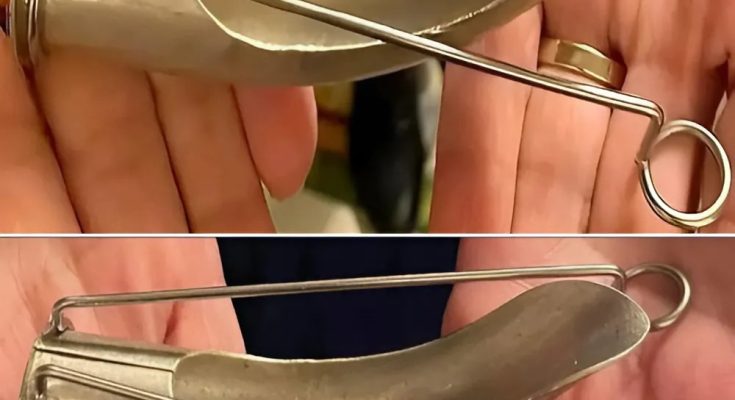Imagine coming across a strange metallic object while digging through a box at a garage sale. It has an intimidating appearance, almost like it was pulled straight out of a medieval torture chamber. Naturally, your imagination kicks into overdrive—could it be an old medical device used in some forgotten surgical procedure, or maybe an industrial tool for a factory job long since obsolete? The shape is odd, the prongs are sharp, and the design is confusing.

But then comes the surprising twist: this mysterious object is actually a kitchen gadget. That’s right—it belongs in your kitchen, not a horror movie. Despite its scary appearance, this odd-looking item is just a juice guide from a mid-20th-century Sunbeam blender, specifically one used in the juicer attachment that came with models from the 1940s through the 1960s. At first glance, that’s hard to believe. The item’s sleek, curved metal and spiky design have baffled countless people online, sparking wild theories ranging from medieval torture instruments to outdated medical contraptions.
But the truth is far more down-to-earth and practical. Back in its heyday, Sunbeam was known for producing reliable, multi-functional kitchen appliances that were built to last. This juice guide was designed to fit inside a juicer attachment and help guide juice smoothly through the spout while keeping pulp and seeds out of your glass. It was part of an innovative, well-engineered system for making fresh juice at home, long before juicing became trendy. So why do so many people jump to wild conclusions when they see it? The answer lies in the way our brains process unfamiliar shapes.
When something doesn’t fit into our everyday visual vocabulary, we tend to associate it with extreme or dramatic functions. A sharp, metallic object doesn’t say “fruit juice” to most people—it screams “dentist drill” or “torture tool.” That’s because context is everything. Without a clear reference point, our minds start grasping for the most intense explanation they can think of. Another reason this object seems so strange is that it doesn’t look like anything found in modern kitchens. Today’s appliances are usually lightweight, streamlined, and made of plastic or silicone. They focus on convenience, ease of use, and visual appeal. But back in the 1940s and ’50s, appliances were built for performance and longevity.
They used durable materials like metal and often had complex designs that served very specific purposes. The juice guide’s odd curves and prongs helped it sit securely in the juicer and allowed it to direct juice efficiently without clogging. It might look intimidating now, but at the time, it was just another smart design choice that made everyday life easier.
The Sunbeam blender was more than just a blender. It was a versatile kitchen tool that could handle a variety of tasks—from juicing to mixing to blending soups. Instead of having a separate device for each job, households relied on attachments like this one to extend the functionality of a single appliance. And that’s part of what made this item go viral when it resurfaced online. People were stunned that something so industrial-looking had a place in the kitchen. Online communities buzzed with guesses, and wild speculation took over. The unexpected reality—that it’s a simple juicing accessory—seemed almost too boring to be true. But the story didn’t end there. For those who grew up with Sunbeam products, the image sparked a wave of nostalgia. They remembered watching their parents or grandparents make juice with the very same attachment. For others, it was a fun and humbling reminder that not everything with sharp edges is scary. Sometimes, it’s just a tool with a very specific purpose. There’s a certain charm to vintage kitchen gadgets. They represent a time when design was focused on functionality and durability, not just flashy looks. In today’s world, where many gadgets are built for one-time use and then tossed, it’s refreshing to rediscover tools that were made to last and designed with thoughtful purpose. The juice guide from the Sunbeam blender isn’t just a quirky piece of metal—it’s a symbol of a different era in home cooking, one where practicality and ingenuity reigned. So the next time you stumble across a mysterious object that looks more like a prop from a horror film than something from your kitchen, take a second to consider its history. Not every strange-looking item is part of a dark past. Sometimes, it’s just an old-school solution to an everyday problem—and a reminder of how far we’ve come while still celebrating the cleverness of the past.


